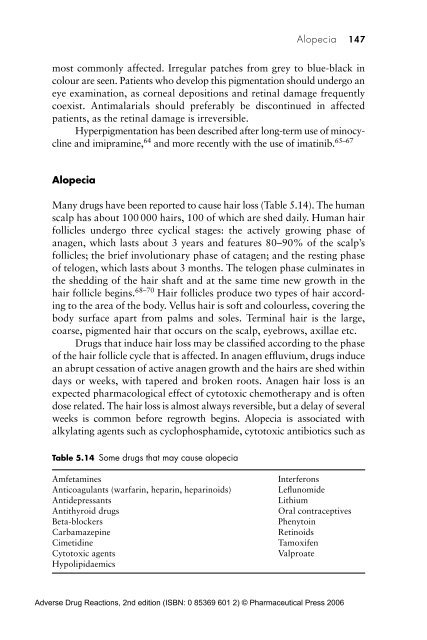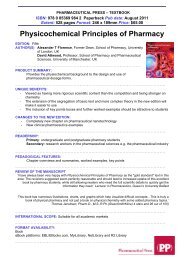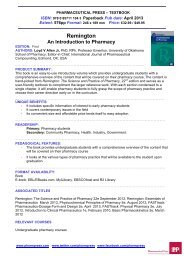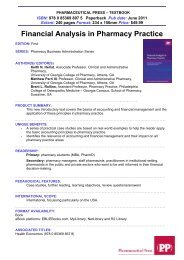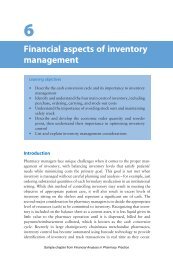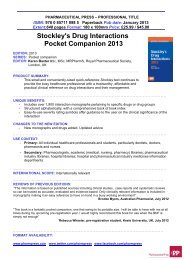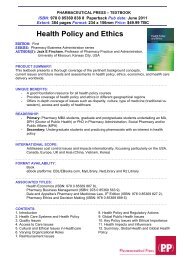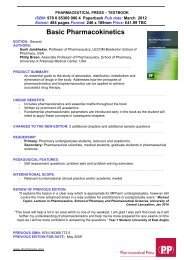Drug-induced skin reactions - Pharmaceutical Press
Drug-induced skin reactions - Pharmaceutical Press
Drug-induced skin reactions - Pharmaceutical Press
Create successful ePaper yourself
Turn your PDF publications into a flip-book with our unique Google optimized e-Paper software.
Alopecia 147<br />
most commonly affected. Irregular patches from grey to blue-black in<br />
colour are seen. Patients who develop this pigmentation should undergo an<br />
eye examination, as corneal depositions and retinal damage frequently<br />
coexist. Antimalarials should preferably be discontinued in affected<br />
patients, as the retinal damage is irreversible.<br />
Hyperpigmentation has been described after long-term use of minocycline<br />
and imipramine, 64 and more recently with the use of imatinib. 65–67<br />
Alopecia<br />
Many drugs have been reported to cause hair loss (Table 5.14). The human<br />
scalp has about 100 000 hairs, 100 of which are shed daily. Human hair<br />
follicles undergo three cyclical stages: the actively growing phase of<br />
anagen, which lasts about 3 years and features 80–90% of the scalp’s<br />
follicles; the brief involutionary phase of catagen; and the resting phase<br />
of telogen, which lasts about 3 months. The telogen phase culminates in<br />
the shedding of the hair shaft and at the same time new growth in the<br />
hair follicle begins. 68–70 Hair follicles produce two types of hair according<br />
to the area of the body. Vellus hair is soft and colourless, covering the<br />
body surface apart from palms and soles. Terminal hair is the large,<br />
coarse, pigmented hair that occurs on the scalp, eyebrows, axillae etc.<br />
<strong>Drug</strong>s that induce hair loss may be classified according to the phase<br />
of the hair follicle cycle that is affected. In anagen effluvium, drugs induce<br />
an abrupt cessation of active anagen growth and the hairs are shed within<br />
days or weeks, with tapered and broken roots. Anagen hair loss is an<br />
expected pharmacological effect of cytotoxic chemotherapy and is often<br />
dose related. The hair loss is almost always reversible, but a delay of several<br />
weeks is common before regrowth begins. Alopecia is associated with<br />
alkylating agents such as cyclophosphamide, cytotoxic antibiotics such as<br />
Table 5.14 Some drugs that may cause alopecia<br />
Amfetamines<br />
Anticoagulants (warfarin, heparin, heparinoids)<br />
Antidepressants<br />
Antithyroid drugs<br />
Beta-blockers<br />
Carbamazepine<br />
Cimetidine<br />
Cytotoxic agents<br />
Hypolipidaemics<br />
Interferons<br />
Leflunomide<br />
Lithium<br />
Oral contraceptives<br />
Phenytoin<br />
Retinoids<br />
Tamoxifen<br />
Valproate<br />
Adverse <strong>Drug</strong> Reactions, 2nd edition (ISBN: 0 85369 601 2) © <strong>Pharmaceutical</strong> <strong>Press</strong> 2006


